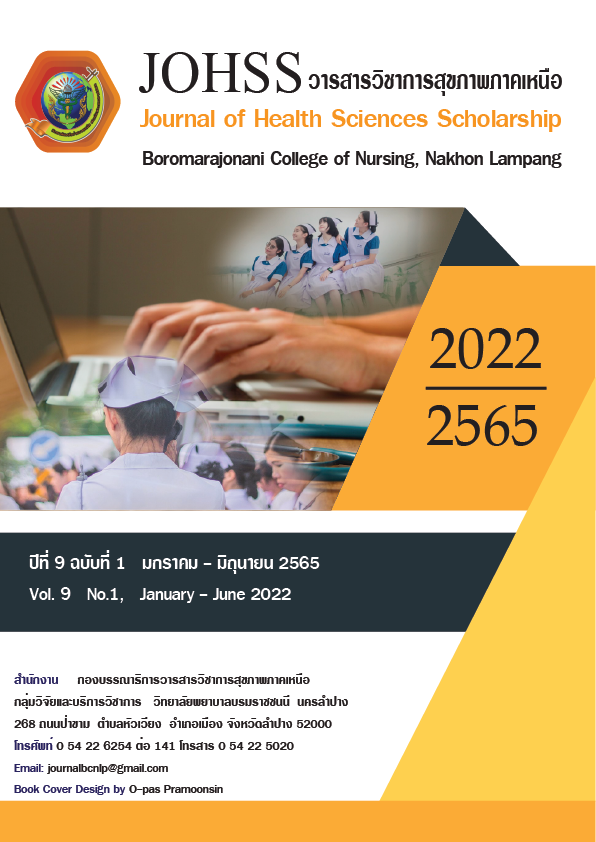การศึกษาผลการใช้สื่อภาพกระบวนการแปรงฟันในการช่วยสื่อสารกระบวนการแปรงฟันแก่เด็กที่มีความต้องการพิเศษโดยผู้ปกครองที่บ้านโรงเรียนวัดช่างเคี่ยน จ.เชียงใหม่
คำสำคัญ:
สื่อภาพกระบวนการแปรงฟัน, เด็กที่มีความต้องการพิเศษ, ผู้ปกครองบทคัดย่อ
ปัญหาโรคฟันผุและโรคเหงือกพบได้สูงในเด็กที่มีความต้องการพิเศษ เมื่อเทียบกับเด็กทั่วไป สาเหตุสำคัญ คือ การแปรงฟันที่ไม่มีประสิทธิภาพ ผู้ปกครองจึงมีบทบาทสำคัญในการแปรงฟันแก่เด็กกลุ่มนี้ รวมถึงฝึกเด็กให้แปรงฟันด้วยตนเอง แต่ด้วยความบกพร่องทางความเข้าใจภาษาและการสื่อสาร ทำให้เด็กไม่ให้ความร่วมมือในการแปรงฟัน ดังนั้นการใช้สื่อภาพจึงเป็นตัวช่วยที่สำคัญในการสื่อสารระหว่างเด็กและผู้ปกครอง งานวิจัยกึ่งทดลองครั้งนี้ มีวัตถุประสงค์เพื่อศึกษาประสิทธิผลการใช้สื่อภาพกระบวนการแปรงฟัน ในการช่วยสื่อสารกระบวนการแปรงฟันแก่เด็กที่มีความต้องการพิเศษโดยผู้ปกครองที่บ้าน ของเด็กในโรงเรียนวัดช่างเคี่ยน จ.เชียงใหม่ ในปีการศึกษา 2564 จำนวน 32 คู่ เครื่องมือที่ใช้ประกอบด้วย แบบสัมภาษณ์ผู้ปกครองเกี่ยวกับข้อมูลทั่วไปของผู้ปกครอง เด็ก และพฤติกรรมทันตสุขภาพของเด็ก และแบบบันทึกปริมาณคราบจุลินทรีย์บนผิวฟันหน้าบนของเด็ก วิเคราะห์ข้อมูลด้วยสถิติเชิงพรรณาและวิเคราะห์เปรียบเทียบผลการศึกษาระหว่างกลุ่มด้วยสถิติ Wilcoxon rank-sum test และสถิติ fisher’s exact test
ผลการศึกษา พบว่า เด็กมีอายุเฉลี่ย 11.20 ปี มีพฤติกรรมแปรงฟันด้วยตนเอง ร้อยละ 96.90 โดยไม่มีผู้ปกครองคอยกำกับดูแล ร้อยละ 34.40 แปรงฟันด้วยตนเองวันละ 2 ครั้ง ร้อยละ 78.10 หลังจากได้รับสื่อภาพกระบวนการแปรงฟันเพื่อใช้ในบ้าน พบว่าเด็กส่วนใหญ่มีพฤติกรรมการแปรงฟันที่ดีขึ้น ร้อยละ 96.90 แปรงฟันอย่างเป็นระบบมีแบบแผนมากขึ้น ร้อยละ 75.00 และปริมาณคราบจุลินทรีย์บนผิวฟันก่อนและหลังการใช้สื่อภาพ ลดลงอย่างมีนัยสำคัญทางสถิติที่ P < .001
สรุป การใช้สื่อภาพกระบวนการแปรงฟันที่บ้านทำให้มีการเปลี่ยนแปลงของทันตสุขภาพและพฤติกรรมการแปรงฟันของเด็กในทางที่ดีขึ้นอย่างชัดเจน
เอกสารอ้างอิง
Alkhabuli, J.O.S., Essa, E.Z., Al-Zuhair, A.M., Jaber, A.A. (2019). Oral health status and treatment needs for children with special needs: a cross-sectional study. Pesquisa Brasileiraem odontopediatria e clínica integrada. 19(4877), 1-10.
Backman, B., Pilebro, C. (1999). Visual pedagogy in dentistry for children with autism. Journal of Dentistry for Children. 66, 325-331.
Bureau of Dental Health. (2018). Report on the results of the 8th National Oral Health Survey, Thailand 2017, 1st edition, Nonthaburi: Sam Charoen Panich. (in Thai).
Campanaro, M., Huebner, C.E., Devis, B.E. (2014). Facilitators and barriers to twice daily tooth brushing among children with special health care needs. Special Care in Dentistry. 34(4), 185-92.
Curnow, M.M., Pine, C.M., Burnside, G., Nicholson, J.A. (2002). A randomized controlled trial of the efficacy of supervised tooth brushing in high-caries-risk children. Caries Research. Jul-Aug; 36(4), 294-306.
Department of health and human services. (2002). Closing the gap: a national blueprint to improve the health of persons with mental retardation is a 2002 report of the surgeon general's conference on health disparities and mental retardation. (Online), Available: https://www.ncbi.nlm.nih.gov/books/NBK44346/. (2020, September 1).
Department of Promotion and Development of the Quality of Life of Persons with Disabilities Ministry of Social Development and Human Security. (2019) Report on the situation of people with disabilities in Thailand. (Online), Available: https://www.m- society.go.th/ewtadmin/ewt/mso_web/ewt_news.php?nid=15511. (2020, September 20). (in Thai).
Gardens, S.J., et al. (2013). Oral health survey of 6–12-year-old children with disabilities attending special schools in Chennai, India. International Journal of Paediatric Dentistry. 24(6), 424-33.
Hennequin, M., Moysan, V., Jourdan, D., Dorin, M., Nicolas, E. (2008). Inequalities in oral health for children with disabilities: a french national survey in special schools. PLoS ONE. 3(6), (1-11).
Huebner, C.E., Riedy, C.A. (2010). Behavioral determinants of brushing young children’s teeth: implication for anticipatory guidance. Pediatric dentistry. 32, 48-55.
Intercountry Centre For Oral Health (2019). Project report for developing dental health media for children with special needs. (Online), Available: article_20201005102714.pdf (moph.go.th). (2021, September 25). (in Thai).
Khoomyat, P., Rujirojananun, P., Kongtaweelerd O., Limsomwong, P. (2015). Guidelines for dental management for special children. (Online), Available: https://th.rajanukul.go.th/_admin/file-download/5-4614-1450157545.pdf. (2020, October 25). (in Thai).
Lamba, R., Rajvanshi, H., Sheikh, Z., Khurana, M., Saha, R. (2015). Oral hygiene needs of special children and the effects of supervised tooth brushing. International Journal of Scientific Study. 3,30-35.
Limsomwong, P. (2015). The application of a visual communication program in conjunction with dental services in children with autism. Rajanukul Journal. 30(1), 25-35. (in Thai).
Makboon, K. (2019). Oral conditions and dental health behaviors of special children in kindergarten Suphanburi Panyanukul School, Suphan Buri Province. Thai Dental Nurse journal. 30(1), 1-14. (in Thai).
Orellana, L.M., Sanchis, S.M., Silvestre, F.J. (2014). Training adults and Children with an autism spectrum disorder to be compliant with a clinical dental assessment using a TEACCH-based approach. Journal of Autism and Developmental Disorders.44, 776–785.
Pilebro, C., Backman, B. (2005). Teaching oral hygiene to children with autism. International Journal of Paediatric Dentistry. 15, 1-9.
Pine, C.M., Curnow, M.M., Burnside, G., Nicholson, J.A. (2000). An intervention program to establish 10Regular tooth brushing; understanding parent's belief and motivating children. International Dental Journal. 312-23.
Roma, W., et al. (2019). The Thai Health Literacy Survey (THL-S) of Thais aged 15 years and above. Nonthaburi. Health Systems Research Institute. (in Thai).
Shin, C.J., Saeed, S. (2013). Toothbrushing barriers for people with developmental disabilities: a pilot study. Special Care in Dentistry. 33(6), 269-74.
ดาวน์โหลด
เผยแพร่แล้ว
ฉบับ
ประเภทบทความ
สัญญาอนุญาต
ลิขสิทธิ์ (c) 2022 วารสารวิชาการสุขภาพภาคเหนือ

อนุญาตภายใต้เงื่อนไข Creative Commons Attribution-NonCommercial-NoDerivatives 4.0 International License.
บทความ ข้อมูล เนื้อหา รูปภาพ ฯลฯ ที่ได้รับการตีพิมพ์ในวารสารวารสารวิชาการสุขภาพภาคเหนือ ถือเป็นลิขสิทธิ์ของวารสารวารสารวิชาการสุขภาพภาคเหนือ หากบุคคลหรือหน่วยงานใดต้องการนำทั้งหมดหรือส่วนหนึ่งส่วนใดไปเผยแพร่ต่อหรือเพื่อกระทำการใดๆ จะต้องได้รับอนุญาตเป็นลายลักอักษรจากวารสารวารสารวิชาการสุขภาพภาคเหนือก่อนเท่านั้น
เนื้อหาและข้อมูลในบทความที่ลงตีพิมพ์ในวารสารวิชาการสุขภาพภาคเหนือถือเป็นข้อคิดเห็นและความรับผิดชอบของผู้เขียนบทความโดยตรงซึ่งกองบรรณาธิการวารสาร ไม่จำเป็นต้องเห็นด้วย หรือร่วมรับผิดชอบใดๆ
อนึ่ง ข้อความและข้อคิดเห็นต่างๆ เป็นของผู้เขียนบทความนั้นๆ ไม่ถือเป็นความเห็นของวารสารฯ และวารสารฯ ไม่จำเป็นต้องเห็นด้วยกับข้อความและข้อคิดเห็นใดๆ ของผู้เขียน วารสารฯ ขอสงวนสิทธิ์ในการพิจารณาตีพิมพ์ตามความเหมาะสม รวมทั้งการตรวจทานแก้ไขหรือขัดเกลาภาษาให้ถูกต้องตามเกณฑ์ที่กำหนด



